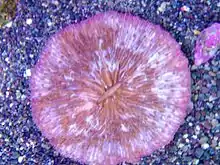Pleuractis paumotensis
Pleuractis paumotensis, commonly called plate coral, is a species of stony coral with a single large polyp. Plate coral are commonly kept in marine aquaria.
| Pleuractis paumotensis | |
|---|---|
 | |
| Scientific classification | |
| Kingdom: | Animalia |
| Phylum: | Cnidaria |
| Class: | Anthozoa |
| Order: | Scleractinia |
| Family: | Fungiidae |
| Genus: | Pleuractis |
| Species: | P. paumotensis |
| Binomial name | |
| Pleuractis paumotensis (Stuchbury, 1833)[1] | |
| Synonyms | |
|
List
| |
Description
Pleuractis paumotensis is a solitary, non-colonial coral that is free living and not attached to the seabed. It is an elongated oval in shape and can grow to a very large size. The polyp can be up to 25 centimetres (9.8 in) long [2] and is embedded in a cup shaped hollow known as a corallite, surrounded by calcareous material. Lining this are narrow ribs known as septa. Outside the corallite wall the ribs continue, now known as costae, bearing rows of tiny spines. The colour is usually brown. The polyp has a central, slit-like mouth and a small number of short, tapering tentacles.[2]
Distribution and habitat
Pleuractis paumotensis occurs in the Indian Ocean on upper reef slopes especially where there is considerable movement of the water as a result of wave action. It is usually found on sand or beds of coral fragments. It is often associated with other species of Fungia.[2]
References
- WoRMS (2018). "Pleuractis paumotensis (Stuchbury, 1833)". WoRMS. World Register of Marine Species. Retrieved 2018-07-27.
- Fungia scutaria Corals of the World online. Retrieved 2011-12-14.

